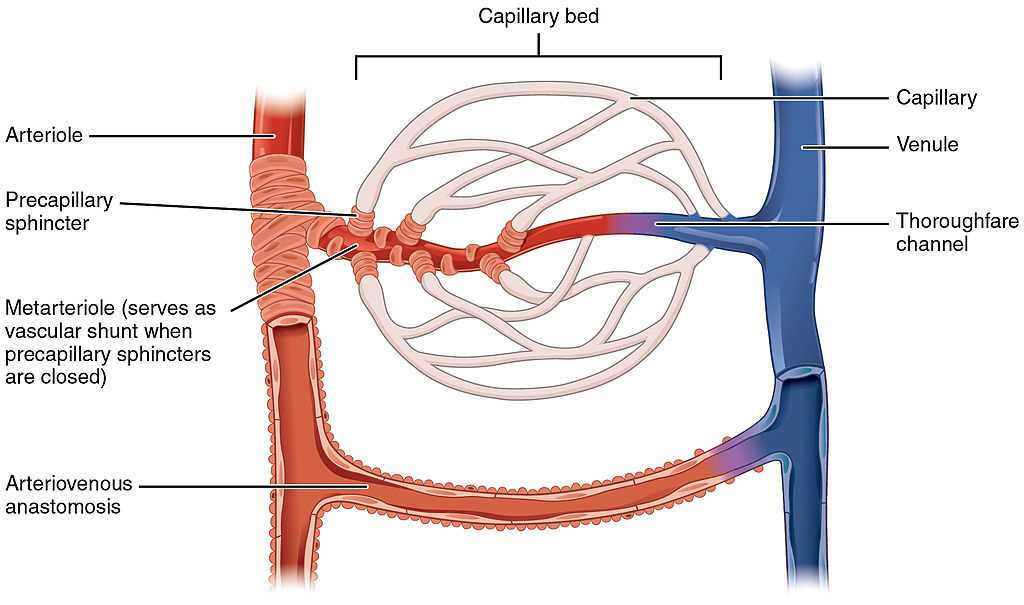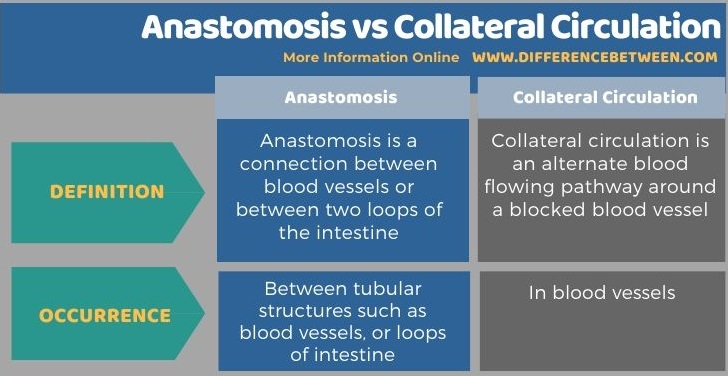Difference Between Anastomosis and Collateral Circulation
Table of Contents
The key difference between anastomosis and collateral circulation is that anastomosis refers to a surgical connection between two structures, especially between blood vessels or between two loops of the intestine, while collateral circulation is an alternate circulation around a blocked artery or vein through another pathway.
Anastomosis refers to a connection between two tubular structures such as blood vessels, two loops of intestine, etc. It is important, and collateral circulation takes place as a result of the this. Meanwhile, collateral circulation is an alternate blood circulating pathway which works when the main blood vessel is blocked or injured. It occurs around a blocked blood vessel, and it supplies enough blood for the tissues. Hence, collateral circulation is very important for patients suffering from ischemic stroke, coronary atherosclerosis and peripheral artery disease.
CONTENTS
1. Overview and Key Difference
2. What is Anastomosis
3. What is Collateral Circulation
4. Similarities Between Anastomosis and Collateral Circulation
5. Side by Side Comparison – Anastomosis vs Collateral Circulation in Tabular Form
6. Summary
What is Anastomosis?
The anastomosis is a connection between two structures, especially between tubular structures. It can be a connection between blood vessels or between two loops of the intestine. Circulatory anastomosis refers to a connection between two blood vessels: two arteries (arterio-arterial anastomosis), two veins (veno-venous anastomosis), or between an artery and a vein (arterio-venous anastomosis).

Figure 01: Anastomosis
Intestinal anastomosis refers to the sewing of two remaining ends of the intestine together after removing a part of intestine surgically. The anastomosis can be normal or abnormal. Moreover, it may be acquired or innate. Abnormal anastomosis that is congenital or acquired is often called fistulas.
What is Collateral Circulation?
Collateral circulation is an alternate blood circulating pathway around a blocked artery or vein. It occurs via preexisting vascular redundancy or via new branches formed between adjacent blood vessels. Therefore, it is a network of specialized endogenous bypass blood vessels. Collateral circulation plays a major role in patients who are suffering from ischemic stroke, coronary atherosclerosis, peripheral artery disease and other conditions and diseases. It provides protection against ischemic injury.

Figure 02: Collateral Circulation in the Retina of Eye
The effectiveness of the collateral circulation in preventing infarction depends on the size of the blood vessels. If the diameter of the collaterals is smaller it is less likely to carry enough blood to prevent infarction. Furthermore, collateral arteries provide an alternative source of blood supply to the myocardium of heart in cases of occlusive coronary artery disease. Therefore, this coronary collateral function prevents possible heart attacks. Moreover, in the human brain, there is a network of collateral arteries in the circle of Willis, which lies at the base of the brain.
Furthermore, collateral circulation is useful in cats in order to supply blood to their hind leg when they have systemic thromboembolism. Even if the main vessel is blocked due to collateral circulation, they get enough blood for their tissues for functioning.
What are the Similarities Between Anastomosis and Collateral Circulation?
- Collateral circulation happens as a result of anastomosis present between adjacent blood vessels.
- Both anastomosis and collateral circulation facilitate the supply of blood into tissues when the main vessels are blocked.
- Both anastomosis and collateral circulation can occur naturally or can be created surgically.
What is the Difference Between Anastomosis and Collateral Circulation?
Anastomosis is a connection between blood vessels or between two loops of the intestine while collateral circulation is an alternate blood flowing pathway around a blocked blood vessel. It is a result of the anastomosis. So, this is the key difference between anastomosis and collateral circulation.

Summary – Anastomosis vs Collateral Circulation
Collateral circulation is a result of the anastomosis. Anastomosis refers to a connection between two tubular structures. It can be a surgical connection or natural connection. Collateral circulation is an alternate blood flowing pathway around a blocked artery or vein. It is a network of collateral vessels and provides protection against ischemic injury. Thus, this is the summary of the difference between anastomosis and collateral circulation.
Reference:
1. “Collateral Circulation”. En.Wikipedia.Org, 2020, Available here.
2. “Anastomosis: Definition, Techniques, Types, And Risks”. Healthline, 2020, Available here.
Image Courtesy:
1. “2105 Capillary Bed” By OpenStax College – Anatomy & Physiology, Connexions Web site, Jun 19, 2013 (CC BY 3.0) via Commons Wikimedia
2. “Collateral vein in central retinal vein occlusion” By Micatlan – Own work (CC BY-SA 4.0) via Commons Wikimedia
ncG1vNJzZmivp6x7pbXFn5yrnZ6YsqOx07CcnqZemLyue8OinZ%2Bdopq7pLGMm5ytr5Wau26tzZqqraedpMCqv4yapZ1lk6S5ra3TnqmapF2YtrOv1KWYraGfo3w%3D